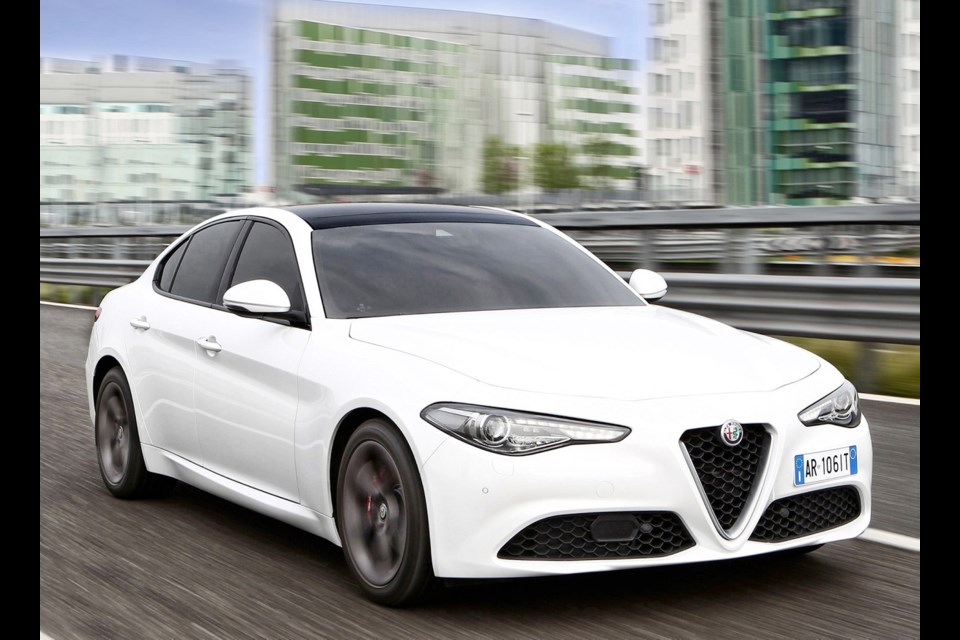If the shape of the 2018 Alfa Romeo Giulia doesn’t get your heart pumping just looking at it, nothing will. But when you get behind the wheel, you won’t feel your beating heart because the performance will take your breath away.
There are few brands out there with a history as rich as Alfa Romeo. The brand, founded in 1910, has been involved with racing since 1911.
It is also deeply Italian, a source of pride that one of their own can take on the best of its European neighbours — from the German Porsche to the British Jaguar.
It was exported to North America from the mid-1950s to 1995.
After a long drought, the marque returned in 2014 with the 4C, a two-seater coupe.
Last year the Giulia, a luxury sport four-door sedan, joined the team — the least-expensive vehicle in the Alfa Romeo lineup.
It is available in three trims, the Giulia, Giulia Ti and Giulia Quadrifoglio, with a base price from $48,995 to $89,495. It is also available in rear wheel or all-wheel-drive configurations.
I got an opportunity to drive a Ti model with all-wheel drive both on road and track.
Depending on your bent, the Ti can also be ordered in one of three levels — the base Ti, the Ti Sport and Ti Lusso. The Sport speaks for itself, the Lusso is the more luxurious version.
The base Ti comes with a direct-injection turbocharged in-line 2.0-litre four-cylinder engine producing 280 horsepower and an eight-speed automatic transmission. Rear-wheel drive is standard, but in sa���ʴ�ý the more popular model would undoubtedly be the all-wheel-drive variant.
(Those who have a deep need for speed would crave the Ferrari-derived V-6 found in the $89,495 Quadrifoglio model, but that review will have to wait for another day.)
The turbo four, with 280 horses and 306 foot-pounds of torque, moves briskly off the line, with a 0-100 km/h time of about 5.2 seconds (according to Alfa Romeo).
Those few seconds and half-seconds are an important measure in a field crowded with BMWs, Mercedes-Benzes, Audis and others.
Alfa has benchmarked the Audi A4, Mercedes-Benz C300, Jaguar XE and Lexus IS as its competition, with more power than the premium models.
With the extra power, Alfa also says the Ti has a 240 km/h top speed, a claim that I was not about to verify. On the highway, the Giulia never seemed to work hard to get to triple-digit speeds.
What amazes me is how quiet the engine sounds. I was expecting a growl or snap to the Italian-designed powerplant. What I got was a very civilized whoosh up to speed. There is no lack of power, just a lack of auditory feedback. The Alfa engineers should perhaps have listened to their own 4C, which sings much more eloquently at speed.
(Those who don’t like any unnecessary audio cues to annoy neighbours may disagree with me.)
But put the Alfa into that first corner, and all complaints about sound fade into the distance as the brand’s DNA comes bubbling to the forefront. The Giulia is a joy on the road and track, with a highly balanced feel and a steering wheel that communicates intimately with the driver.
I would also say it is very forgiving, allowing a weekend warrior (such as myself) the time to gather confidence with each lap.
The interior is both clean and contemporary, with a minimum of extraneous knobs or switches. The cabin isn’t as utilitarian and cold as some German makes, but it also isn’t a sea of chrome like the Americans.
If pushed, I might say it has more in common with the British, with soft sensuous lines that begged to be touched and warm colours that make the cabin a relaxing space for both eye and body.
My tester had an 8.8-inch widescreen infotainment screen at the top of the centre stack. The display is good, but not the best example in the luxury segment.
The driver also faces a seven-inch thin-film-transistor cluster display, which I found more attractive than the larger infotainment screen.
The Alfa Romeo Giulia is like a breath of fresh air in a field dominated by generic German sedans. It appeals to the enthusiast by its enthusiasm on the road and its nicely balanced chassis on the track.
Those with deeper pockets — and the urge to humiliate the competition — should search out the Quadrifoglio.
Regardless of which you choose, the Giulia is sure to steal your heart.
THE SPEC SHEET
Type: Mid-sized luxury-sport four-door sedan, front engine, all-wheel-drive
Engine: Turbocharged 2.0-litre four-cylinder, 280 hp at 5,200 r.p.m., 306 lb.-ft. of torque at 2,000 to 4,800 r.p.m.
Transmission: Eight-speed automatic
Dimensions (mm): Length, 4,638; width, 1,872; height, 1,450; wheelbase, 2,819
Curb weight (kg): 1,530
Price (base/as tested): $52,995/ $65,435 (includes $1,795 freight and PDI and $100 AC tax)
Options: Driver assistance package $1,000, Leather package $1,000, Driver Assistance Dynamic Plus $1,500, Performance package $1,750, Dual pane sunroof $1,595, Harman/Kardon audio system $1,200, Tri-coat paint $2,500
Tires: 225/45 R18 on alloy wheels
Fuel type: Premium
Fuel economy (L/100km): 10.2 city/ 6.0 highway
Warranty: Four years/80,000 km new car



